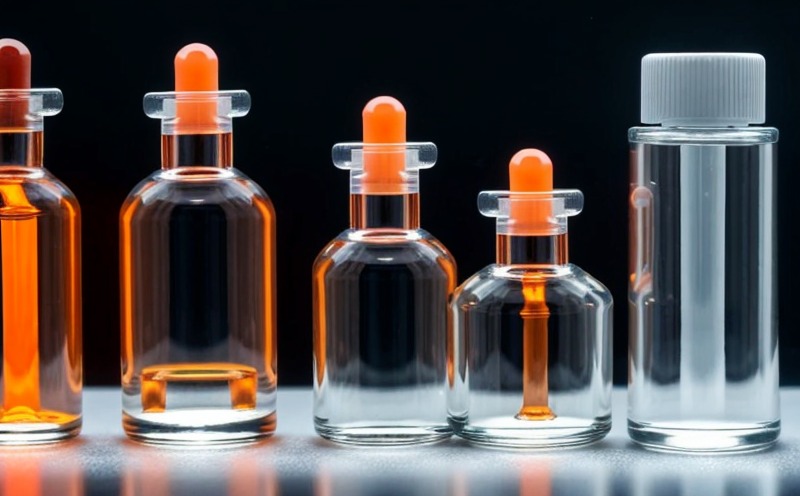ISO 22412 Particle Size Analysis in Nanotoxicology by DLS
The analysis of particle size distribution is crucial in nanotoxicology to understand how nanoparticles behave within biological systems. The ISO 22412 standard provides a robust framework for determining the particle size distribution using Dynamic Light Scattering (DLS). This method is particularly valuable in nanotoxicology because it allows for the precise measurement of nanoparticles, which can influence their interaction with biological systems.
The process involves dispersing the sample in a suitable medium and measuring the scattering of light as it passes through the suspension. The intensity of scattered light at various angles provides information about particle size distribution. This technique is non-destructive and allows for real-time analysis, making it ideal for monitoring nanoparticle aggregation or disaggregation processes.
The ISO 22412 standard specifies detailed procedures to ensure accurate and reproducible results. It outlines the necessary equipment, sample preparation, data acquisition, and data interpretation steps. Compliance with this standard is essential for regulatory compliance and ensures that the test results are reliable and comparable across different laboratories.
For accurate particle size analysis using ISO 22412 DLS, the specimen must be carefully prepared to minimize contamination and ensure uniform dispersion of nanoparticles in the medium. This involves thorough cleaning of all instruments used in the procedure and ensuring that the sample is free from agglomerates or other contaminants.
The choice of solvent and dispersant can significantly affect the results. The standard provides guidelines on selecting appropriate solvents and dispersants to achieve optimal particle dispersion for accurate size measurement. It also specifies the temperature range within which measurements should be conducted, as changes in temperature can alter the viscosity of the medium and thus affect scattering patterns.
The ISO 22412 DLS technique is widely used in nanotoxicology research to assess the potential health risks associated with nanoparticles. By accurately determining particle size distribution, researchers can better understand how different nanoparticle sizes may interact with biological systems. This information is critical for developing safer materials and products.
Moreover, ISO 22412 DLS analysis plays a vital role in quality control within the manufacturing process of nanomaterials. It allows manufacturers to monitor particle size distribution throughout production, ensuring consistency and meeting regulatory requirements. Regulatory bodies like the EPA and the European Union's REACH regulation often require such analyses as part of their risk assessment procedures.
The technique is also valuable in environmental monitoring. Nanoparticles can enter ecosystems through various pathways, and understanding their size distribution helps in assessing potential ecological impacts. By adhering to ISO 22412 standards, laboratories ensure that their testing methods are consistent and reliable, contributing to more accurate risk assessments.
In summary, ISO 22412 DLS is a fundamental tool in nanotoxicology for particle size analysis. Its adherence to international standards ensures the accuracy and reliability of test results, which are crucial for both research and regulatory compliance. By providing detailed procedures and guidelines, this standard helps laboratories achieve consistent and reproducible results.
Benefits
- Precision: ISO 22412 DLS offers high precision in particle size determination, which is essential for understanding nanoparticle behavior within biological systems.
- Non-Destructive: The technique does not alter the sample, allowing for real-time monitoring of nanoparticle properties.
- Reproducibility: Adherence to ISO 22412 ensures that results are consistent across different laboratories and over time.
- Compliance: Compliance with international standards is crucial for regulatory approval and ensuring product safety.
The use of this standard contributes to the development of safer nanomaterials by providing accurate data on particle size distribution, which is critical for assessing potential health risks. Additionally, it supports quality control in manufacturing processes and environmental monitoring, ensuring that nanoparticles do not pose an undue risk to human health or ecosystems.
International Acceptance and Recognition
- The ISO 22412 standard has gained widespread acceptance among regulatory bodies such as the EPA, EU's REACH, and other national agencies responsible for nanomaterial regulation.
- This international recognition ensures that results from DLS analysis conducted in one laboratory are accepted by others, facilitating global collaboration in research and development.
ISO 22412 is not only recognized in the United States but also in Europe, Asia, and other regions where nanotechnology plays a significant role. The standard's broad acceptance reflects its reliability and consistency across different testing environments.
| Regulatory Body | Acceptance of ISO 22412 DLS |
|---|---|
| EPA (Environmental Protection Agency) | Required for nanomaterial risk assessment |
| EU REACH Regulation | Mandatory for reporting particle size distribution in nanomaterials |
| National Nanotechnology Initiative (NNI) - USA | Recommended best practice for nanotoxicology research |
| Australian Centre for Nanoscale Science | Adopted as a standard in toxicological studies |
The international acceptance of ISO 22412 DLS underscores its importance in the global nanotechnology community. Laboratories that adhere to this standard can confidently present their results, knowing they meet the highest international standards and are recognized by leading regulatory bodies.
Use Cases and Application Examples
- Risk Assessment: Assessing the potential health risks associated with nanoparticles in various industries including pharmaceuticals, cosmetics, and electronics.
- Quality Control: Ensuring consistent particle size distribution in nanomaterial manufacturing processes to meet regulatory requirements.
- Environmental Monitoring: Evaluating nanoparticle impacts on ecosystems and identifying potential environmental risks.
| Use Case | Description |
|---|---|
| Risk Assessment in Pharmaceuticals | Determining the particle size distribution of drug nanoparticles to assess their potential toxicity and efficacy. |
| Quality Control in Cosmetics | Maintaining consistent nanoparticle sizes in cosmetic formulations for safety and effectiveness. |
| Environmental Monitoring in Electronics | Evaluating the environmental impact of nanoparticles used in electronics manufacturing. |
The ISO 22412 DLS technique is versatile, applicable across various sectors, and plays a critical role in ensuring the safety and efficacy of nanomaterials. Its use cases extend beyond mere compliance; it supports innovation by providing reliable data that informs safer product development.





